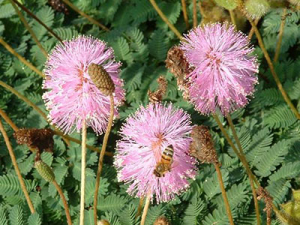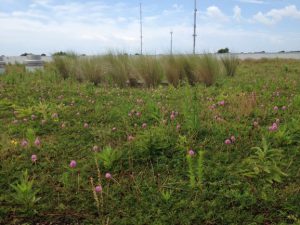
Remember the “Truffula Trees” in Dr. Seuss’s classic children’s book, The Lorax? They were tall, thin-trunked trees with fluffs of bright color on top. I am immediately reminded of that book any time I walk among powderpuff (or “sunshine”) mimosa (Mimosa strigillosa). A low-growing, running groundcover with bright green leaflets, its most noticeable feature is the pinkish purple puff-ball bloom. Not only does it attract human interest, but bees’ as well.

It is rare that I walk past the powderpuff mimosa in our demonstration garden that I don’t see bees of all kinds visiting the blooms. Each flower is composed of hundreds of stamens punctuated by bright yellow pollen.
Another interesting feature of the plant is that when touched, its leaflets will fold up. Similar varieties of Mimosa are called “sensitive plants” because of this response. The plant folds its leaves in the evening to conserve water and pollen. The theory for folding in response to touch is that the plant appears wilted, possibly encouraging grazing animals to move on to a healthier-looking plant. It is easy see the ways animals protect themselves with teeth, claws, and evasive behavior, but self-preservation in plants can be absolutely fascinating.

Despite its shared common name, this plant is not related to the invasive mimosa tree, Albizia julibrissin. Powderpuff mimosa is native to the Gulf Coast and southern United States. Named in 2008 by the Florida Nursery, Growers and Landscape Association (FNGLA) as a plant of the year, powderpuff mimosa has a lot of desirable features in a landscape plant. In my copy of A Gardener’s Guide to Florida’s Native Plants, under “Maintenance” the description is, “None.” You can literally plug a small piece of this plant into nearly any type of soil and it will take off and grow. Its preferred habitat is moist soil in full sun, but it does well in sandy areas and is very drought tolerant. Its ease of growth does mean that it will spread anywhere you want it to (and maybe some you don’t), but if you have other groundcovers or paved areas you can easily trim it back.
 1
1
